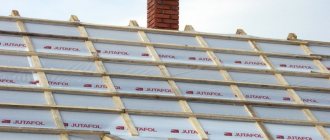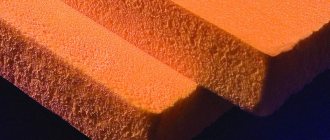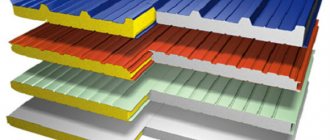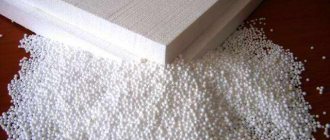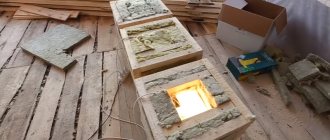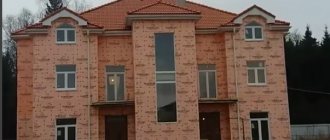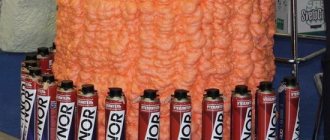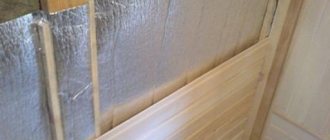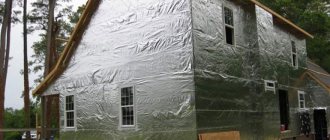Table of thermal conductivity of thermal insulation materials
To make it easier to keep your house warm in winter and cool in summer, the thermal conductivity of walls, floors and roofs must be at least a certain figure, which is calculated for each region.
The composition of the “pie” of walls, floor and ceiling, the thickness of the materials are taken into account so that the total figure is no less (or better yet, at least a little more) recommended for your region. Heat transfer coefficient of modern building materials for enclosing structures
When choosing materials, it is necessary to take into account that some of them (not all) conduct heat much better in conditions of high humidity. If such a situation may occur for a long period of time during operation, the thermal conductivity for this condition is used in the calculations. The thermal conductivity coefficients of the main materials used for insulation are given in the table.
| Name of material | Thermal conductivity coefficient W/(m °C) | ||
| Dry | At normal humidity | At high humidity | |
| Woolen felt | 0,036-0,041 | 0,038-0,044 | 0,044-0,050 |
| Stone mineral wool 25-50 kg/m3 | 0,036 | 0,042 | 0,,045 |
| Stone mineral wool 40-60 kg/m3 | 0,035 | 0,041 | 0,044 |
| Stone mineral wool 80-125 kg/m3 | 0,036 | 0,042 | 0,045 |
| Stone mineral wool 140-175 kg/m3 | 0,037 | 0,043 | 0,0456 |
| Stone mineral wool 180 kg/m3 | 0,038 | 0,045 | 0,048 |
| Glass wool 15 kg/m3 | 0,046 | 0,049 | 0,055 |
| Glass wool 17 kg/m3 | 0,044 | 0,047 | 0,053 |
| Glass wool 20 kg/m3 | 0,04 | 0,043 | 0,048 |
| Glass wool 30 kg/m3 | 0,04 | 0,042 | 0,046 |
| Glass wool 35 kg/m3 | 0,039 | 0,041 | 0,046 |
| Glass wool 45 kg/m3 | 0,039 | 0,041 | 0,045 |
| Glass wool 60 kg/m3 | 0,038 | 0,040 | 0,045 |
| Glass wool 75 kg/m3 | 0,04 | 0,042 | 0,047 |
| Glass wool 85 kg/m3 | 0,044 | 0,046 | 0,050 |
| Expanded polystyrene (foam plastic, EPS) | 0,036-0,041 | 0,038-0,044 | 0,044-0,050 |
| Extruded polystyrene foam (EPS, XPS) | 0,029 | 0,030 | 0,031 |
| Foam concrete, aerated concrete with cement mortar, 600 kg/m3 | 0,14 | 0,22 | 0,26 |
| Foam concrete, aerated concrete with cement mortar, 400 kg/m3 | 0,11 | 0,14 | 0,15 |
| Foam concrete, aerated concrete with lime mortar, 600 kg/m3 | 0,15 | 0,28 | 0,34 |
| Foam concrete, aerated concrete with lime mortar, 400 kg/m3 | 0,13 | 0,22 | 0,28 |
| Foam glass, crumbs, 100 - 150 kg/m3 | 0,043-0,06 | ||
| Foam glass, crumbs, 151 - 200 kg/m3 | 0,06-0,063 | ||
| Foam glass, crumbs, 201 - 250 kg/m3 | 0,066-0,073 | ||
| Foam glass, crumbs, 251 - 400 kg/m3 | 0,085-0,1 | ||
| Foam block 100 - 120 kg/m3 | 0,043-0,045 | ||
| Foam block 121-170 kg/m3 | 0,05-0,062 | ||
| Foam block 171 - 220 kg/m3 | 0,057-0,063 | ||
| Foam block 221 - 270 kg/m3 | 0,073 | ||
| Ecowool | 0,037-0,042 | ||
| Polyurethane foam (PPU) 40 kg/m3 | 0,029 | 0,031 | 0,05 |
| Polyurethane foam (PPU) 60 kg/m3 | 0,035 | 0,036 | 0,041 |
| Polyurethane foam (PPU) 80 kg/m3 | 0,041 | 0,042 | 0,04 |
| Cross-linked polyethylene foam | 0,031-0,038 | ||
| Vacuum | |||
| Air +27°C. 1 atm | 0,026 | ||
| Xenon | 0,0057 | ||
| Argon | 0,0177 | ||
| Airgel (Aspen aerogels) | 0,014-0,021 | ||
| Slag | 0,05 | ||
| Vermiculite | 0,064-0,074 | ||
| Foam rubber | 0,033 | ||
| Cork sheets 220 kg/m3 | 0,035 | ||
| Cork sheets 260 kg/m3 | 0,05 | ||
| Basalt mats, canvases | 0,03-0,04 | ||
| Tow | 0,05 | ||
| Perlite, 200 kg/m3 | 0,05 | ||
| Expanded perlite, 100 kg/m3 | 0,06 | ||
| Linen insulating boards, 250 kg/m3 | 0,054 | ||
| Polystyrene concrete, 150-500 kg/m3 | 0,052-0,145 | ||
| Granulated cork, 45 kg/m3 | 0,038 | ||
| Mineral cork on a bitumen basis, 270-350 kg/m3 | 0,076-0,096 | ||
| Cork flooring, 540 kg/m3 | 0,078 | ||
| Technical cork, 50 kg/m3 | 0,037 |
Some of the information is taken from standards that prescribe the characteristics of certain materials (SNiP 23-02-2003, SP 50.13330.2012, SNiP II-3-79* (Appendix 2)). Those materials that are not specified in the standards are found on the manufacturers’ websites
Since there are no standards, they can differ significantly from different manufacturers, so when purchasing, pay attention to the characteristics of each material purchased
Description and influence
Density is a value that is inversely proportional to the porosity of the insulation. Porous materials retain heat and create a kind of buffer. Therefore, the conclusion arises about how density affects: the higher the specific gravity, the less thermal insulation properties the insulator has.
A good example
For example, birch timber - 500-770 kg/m3, basalt fiber - 50-200 kg/m3. And the thermal conductivity coefficient of birch is 0.15 W with the same fiber index of 0.03-0.05 W. Thus, porous mineral insulation retains heat almost 5 times more efficiently than denser wooden beams.
It is precisely because of their specific gravity that even thick, reliable walls do not always provide good thermal protection. But a thin layer of insulation can correct this problem. In addition, low specific gravity gives less load on structures: cellular concrete with a low thermal conductivity coefficient of 0.1 W is not suitable for insulating thin walls and frame buildings since its density is almost 400 kg/m3.
Density provides resistance to mechanical stress, so insulators with low specific gravity require a protective layer. Such materials include penoizol, polystyrene foam and penoplex, as well as mineral wool.
Methods for determining CTP
Calculation of insulation thickness.
characteristics of building materials and thermal conductivity coefficient There are 2 methods for determining CTP:
- Stationary – involves working with parameters that will not change for a long time or change slightly. The advantage of this method is the high accuracy of calculation of the result. The disadvantages include the difficulty of adjusting the experiment, the large number of thermocouples used, as well as the length of time spent preparing and conducting the experiment. This method is suitable for calculating the CFT of liquids and gases if energy transfer by convection and radiation is not taken into account.
- Non-stationary - visually looks simpler and requires from 10 to 30 minutes to complete. It has found its wide application due to the fact that in the process of research it is possible to find out not only the thermal conductivity, but also the temperature conductivity, as well as the heat capacity of the sample.
To analyze the thermal conductivity of building materials, electronic devices are used, for example, ITP-MG4 “Zond”. Such tools for calculating the CTP differ in the operating temperature range, as well as the percentage of error.
Table of thermal efficiency of materials
Properties of insulation and thermal conductivity table of building materials
Most raw materials used in construction do not require independent measurement of the CTP. For this purpose, there is a table of thermal conductivity of materials, which shows the main characteristics required for calculating thermal efficiency.
| Material | Density, kg/m3 | Thermal conductivity, W/(m*degrees) | Heat capacity J/(kg*degrees) |
| Reinforced concrete | 2500 | 1,7 | 840 |
| Concrete on gravel or crushed stone from natural stone | 2400 | 1,51 | 840 |
| Lightweight expanded clay concrete | 500-1200 | 1,19-0,45 | 840 |
| Construction brick | 800-1500 | 0,24-0,3 | 800 |
| Sand-lime brick | 1000-2200 | 0,51-1,29 | 750-840 |
| Iron | 7870 | 70-80 | 450 |
| Expanded polystyrene Penoplex | 110-140 | 0,042-0,05 | 1600 |
| Mineral wool slabs | 150-250 | 0,043-0,063 | — |
Most materials differ in their composition. For example, the thermal conductivity of a brick depends on what it is made of. Clinker has a CFC from 0.8 to 1.6, and silica 0.15. There are also differences in the manufacturing method and GOST standards.
Expanded polystyrene of different thicknessesSource cmp24.com.ua
Comparative characteristics of insulation materials
In order to make the right choice, you need to understand the difference between one insulation and another.
| Name | Moisture absorption(%) | Flammability | Vapor permeability Mg/m*h*Pa | Thermal conductivity W/m*K |
| Mineral wool | 1,5 | does not burn | 0,49 – 0,6 | 0,037 – 0,048 |
| PPU | 2,0 | burns moderately | 0,02 | 0,023 – 0,035 |
| Styrofoam | 3,0 | burns intensely | 0,03 | 0,036 – 0,041 |
| Ecowool | 1,0 | burns moderately | 0,3 | 0,032 – 0,041 |
| Penoizol | 18,0 | burns low | 0,21 – 0,24 | 0,028 – 0,034 |
To purchase the thermal insulation material you need, you need to pay attention to the following factors:
- where it will be used (for external or internal work);
- it will be laid vertically or horizontally;
- preload on the material;
- the need for sound insulation;
- weather conditions in a particular region.

The functionality of the insulated structure is also of great importance. For example, for commercial buildings, preference should be given to material with significant density and the impossibility of damage by small rodents or other pests.
Briefly about the main thing
Thermal conductivity coefficient is the rate of heat transfer through a material over a certain time.
Knowledge of CTP is necessary to improve the thermal efficiency of the structure. For example, if it must quickly give off heat, then it must be made from raw materials with high energy transfer, but for enclosed spaces, on the contrary, additional insulation is needed. This will help save money on heating.
The thermal conductivity of a material is affected by its density, moisture content and fiber content.
The concept of thermal conductivity
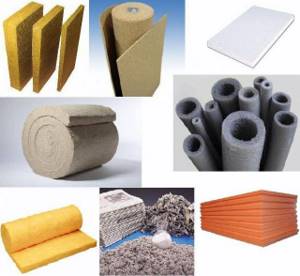
Thermal conductivity refers to the transfer of heat energy from object to object until the moment of thermal equilibrium, i.e. temperature equalization. In relation to a private house, the speed of the process is important - the longer the leveling takes place, the less the structure cools down.
In numerical form, the phenomenon is expressed through the thermal conductivity coefficient. The indicator clearly expresses the passage of the amount of heat in a certain time through a unit of surface. The larger the value, the faster the thermal energy flows away.
The heat transfer properties of various materials are indicated in the manufacturer's specifications on the packaging.
“Types of heat transfer: thermal conductivity, convection, radiation”
Heat transfer is a way of changing the internal energy of a body by transferring energy from one part of the body to another or from one body to another without doing work. The following types of heat transfer exist: conduction, convection and radiation.
Thermal conductivity
Thermal conduction is the process of transferring energy from one body to another or from one part of a body to another due to the thermal movement of particles
It is important that during thermal conduction there is no movement of matter; energy is transferred from one body to another or from one part of the body to another
Different substances have different thermal conductivities. If you put a piece of ice at the bottom of a test tube filled with water and place its upper end over the flame of an alcohol lamp, then after a while the water in the upper part of the test tube will boil, but the ice will not melt. Consequently, water, like all liquids, has poor thermal conductivity.
Gases have even poorer thermal conductivity. Let's take a test tube containing nothing but air, and place it over the flame of an alcohol lamp. A finger placed in a test tube will not feel any heat. Consequently, air and other gases have poor thermal conductivity.
Metals are good conductors of heat, while highly rarefied gases are the worst. This is explained by the peculiarities of their structure. Molecules of gases are located at distances from each other that are greater than molecules of solids, and collide much less frequently. Therefore, the transfer of energy from one molecules to others in gases does not occur as intensely as in solids. The thermal conductivity of a liquid is intermediate between the thermal conductivity of gases and solids.
Convection
As is known, gases and liquids conduct heat poorly. At the same time, the air is heated from steam heating batteries. This occurs due to a type of thermal conductivity called convection.
If a pinwheel made of paper is placed over a heat source, the pinwheel will begin to rotate. This happens because the heated, less dense layers of air rise upward under the action of the buoyant force, and the colder ones move down and take their place, which leads to the rotation of the turntable.
Convection is a type of heat transfer in which energy is transferred through layers of liquid or gas. Convection is associated with the transfer of matter, so it can only occur in liquids and gases; Convection does not occur in solids.
Radiation
The third type of heat transfer is radiation. If you bring your hand to the coil of an electric stove plugged in, to a burning light bulb, to a heated iron, to a radiator, etc., you can clearly feel the heat.
Experiments also show that black bodies absorb and emit energy well, while white or shiny bodies emit and absorb it poorly. They reflect energy well. Therefore, it is understandable why people wear light-colored clothes in the summer, and why they prefer to paint houses in the south white.
By radiation, energy is transferred from the Sun to the Earth. Since the space between the Sun and the Earth is a vacuum (the height of the Earth’s atmosphere is much less than the distance from it to the Sun), energy cannot be transferred either by convection or by thermal conduction. Thus, the transfer of energy by radiation does not require the presence of any medium; this heat transfer can also be carried out in a vacuum.
Lesson summary “Types of heat transfer: thermal conductivity, convection, radiation.”
Next topic: “Amount of heat. Specific heat".
Total thermal resistance
The total thermal resistance 0 is equal to the sum of the partial thermal resistances.
The total thermal resistance of scale R formed in ship evaporators depends on a number of variable factors, which does not allow its numerical values to be normalized.
The total thermal resistance of the wall R is 1 1 m hour deg / kcal. Thermal resistance to heat perception and heat transfer is equal to: RB 0 133 m hour deg / kcal, R0 Qfi5 m2 hour deg / kcal.
| Reducing the cross-section of exhaust shafts compared to its calculated cross-section, if it exceeds 0 65 m2. |
The total thermal resistance of external walls should be in the range from 0 4 to 1, depending on wind influences and the temperature conditions of the wall. The thermal resistance of the barn roof should be one and a half times greater than the resistance of the walls. In barns, the dimensions of which do not exceed those indicated, and the thermal properties of the fences correspond to the given characteristics, air exchange should be in the range from 95 to 13 air per hour for every 500 kg of live weight of cows.
Let's compare the general thermal resistances.
Since the total thermal resistance consists of partial thermal resistances, it is quite obvious that in the case of a multilayer wall, the thermal resistance of each layer must be taken into account.
Since the total thermal resistance consists of partial thermal resistances, it is quite obvious that for a multilayer wall the thermal resistance of each layer must be taken into account.
Knowing the total thermal resistance of the fence or its overall heat transfer coefficient at given (v and / n), you can quite simply determine the temperature of the surfaces of the fence.
| Dependence of the thermal resistance of the actual contact on the load.| Diagram of an idealized push-button contact. |
The change in overall thermal resistance as a function of compression forces mainly depends on the change in conductivity through the actual contact points.
The value of the total thermal resistance to heat transfer (0) of the enclosing structure depends on the physical properties of the material and for a given specific structure can be determined regardless of external conditions. In order to check the correctness of the chosen fencing design, it is necessary to determine what heat transfer resistance (tr) is required for the fencing structures of the designed building, taking into account climatic conditions, temperature and humidity conditions of the room and the degree of massiveness of the fencing.
| Schemes of adhesive-metal connection with various surfaces. |
Let's consider the components of the overall thermal resistance of the adhesive layer.
Practical application of the thermal conductivity value of building materials
The concept of the thickness of the material layer directly follows from the concept of thermal conductivity to obtain the required value of heat flow resistance. Thermal resistance is a standardized value.
A simplified formula that determines the thickness of the layer will look like:
Table of thermal conductivity of insulation materials.
where, H layer thickness, m,
R heat transfer resistance, (m2*°С)/W,
λ thermal conductivity coefficient, W/(m*°C).
This formula, when applied to a wall or ceiling, has the following assumptions:
- the enclosing structure has a homogeneous monolithic structure,
- the building materials used have natural moisture.
When designing, the necessary standardized and reference data are taken from the regulatory documentation:
- SNiP23-01-99 Construction climatology,
- SNiP 02/23/2003 Thermal protection of buildings,
- SP 23-101-2004 Design of thermal protection of buildings.
Return to contents
How to calculate wall thickness
In order for the house to be warm in winter and cool in summer, it is necessary that the enclosing structures (walls, floor, ceiling/roof) must have a certain thermal resistance. This value is different for each region. It depends on the average temperatures and humidity in a particular area.
Thermal resistance of enclosing structures for regions of Russia
In order for heating bills not to be too high, it is necessary to select building materials and their thickness so that their total thermal resistance is not less than that indicated in the table.
Calculation of wall thickness, insulation thickness, finishing layers
Modern construction is characterized by a situation where the wall has several layers. In addition to the supporting structure, there is insulation and finishing materials. Each layer has its own thickness. How to determine the thickness of insulation? The calculation is simple. Based on the formula:
Formula for calculating thermal resistance
R—thermal resistance;
p—layer thickness in meters;
k is the thermal conductivity coefficient.
First you need to decide on the materials that you will use during construction. Moreover, you need to know exactly what type of wall material, insulation, finishing, etc. will be. After all, each of them makes its contribution to thermal insulation, and the thermal conductivity of building materials is taken into account in the calculation.
First, the thermal resistance of the structural material (from which the wall, ceiling, etc. will be built) is calculated, then the thickness of the selected insulation is selected based on the “residual” principle. You can also take into account the thermal insulation characteristics of finishing materials, but usually they are a plus to the main ones. This is how a certain reserve is laid down “just in case.” This reserve allows you to save on heating, which subsequently has a positive effect on the budget.
An example of calculating the thickness of insulation
Let's look at it with an example. We are going to build a brick wall - one and a half bricks long, and we will insulate it with mineral wool. According to the table, the thermal resistance of walls for the region should be at least 3.5. The calculation for this situation is given below.
- First, let's calculate the thermal resistance of a brick wall. One and a half bricks is 38 cm or 0.38 meters, the thermal conductivity coefficient of brickwork is 0.56. We calculate using the above formula: 0.38/0.56 = 0.68. A wall of 1.5 bricks has this thermal resistance.
- We subtract this value from the total thermal resistance for the region: 3.5-0.68 = 2.82.
This value must be “added” with thermal insulation and finishing materials. All enclosing structures will have to be calculated - We calculate the thickness of mineral wool. Its thermal conductivity coefficient is 0.045. The thickness of the layer will be: 2.82 * 0.045 = 0.1269 m or 12.7 cm. That is, to ensure the required level of insulation, the thickness of the mineral wool layer must be at least 13 cm.
If the budget is limited, you can take 10 cm of mineral wool, and the missing amount will be covered with finishing materials. They will be inside and outside. But, if you want your heating bills to be minimal, it is better to use the finishing as a “plus” to the calculated value. This is your reserve during the lowest temperatures, since thermal resistance standards for enclosing structures are calculated based on the average temperature over several years, and winters can be abnormally cold
Therefore, the thermal conductivity of building materials used for finishing is simply not taken into account
Factors influencing thermal conductivity
Thermal conductivity depends on the density and thickness of the insulation, so it is important to take it into account when purchasing. Density is the mass of one cubic meter of materials, which according to this criterion are classified as very light, light, medium and hard. Lightweight porous products are used to cover interior walls and load-bearing partitions, while dense ones are used for exterior work.
Modifications with lower density are lighter in weight, but have better thermal conductivity parameters. A comparison of insulation materials by density is presented in the table.
| Material | Density indicator, kg/m3 |
| Minvata | 50-200 |
| Extruded polystyrene foam | 33-150 |
| Polyurethane foam | 30-80 |
| Polyurethane mastic | 1400 |
| Ruberoid | 600 |
| Polyethylene | 1500 |
The higher the density, the lower the level of vapor barrier.
The thickness of the material also affects the degree of heat transfer. If it is excessive, the natural ventilation of the premises is disrupted. Small thickness causes cold bridges and condensation on the surface. As a result, the wall will become covered with mold and mildew. You can compare the thickness parameters of materials in the table.
| Material | Thickness, mm |
| Penoplex | 20 |
| Minvata | 38 |
| Cellular concrete | 270 |
| Brickwork | 370 |
When selecting thickness, it is worth taking into account the climate of the area and the material of construction.
Thermal resistance of windows
In the air, particles that participate in heat exchange are located at a considerable distance from each other, and therefore, air isolated in a sealed space is the best insulation. Therefore, all wooden windows used to be made with two rows of sashes. Thanks to the air gap between the frames, the heat transfer resistance of windows increases. The same principle applies to entrance doors in a private house. To create such an air gap, they place two doors at some distance from each other or make a dressing room.
This principle remains in modern plastic windows. The only difference is that the high heat transfer resistance of double-glazed windows is achieved not due to the air gap, but due to sealed glass chambers from which the air is evacuated. In such chambers the air is rarefied and there are practically no particles, which means there is nothing to transfer temperature to. Therefore, the thermal insulation properties of modern double-glazed windows are much higher than those of old wooden windows. The thermal resistance of such a double-glazed window is 0.4 (m2*°C)/W.

Modern entrance doors for private houses have a multi-layer structure with one or several layers of insulation. In addition, additional thermal resistance is provided by the installation of rubber or silicone seals. Thanks to this, the door becomes practically airtight and the installation of a second one is not required.
Density of floor insulation
If you choose the right floor insulation, you can save a third of your heat payment. You can use heated floors, or you can use insulation. The main thing is to make the right choice. It is not recommended to use materials that are too thin, as their benefits are minimal. Too much thickness will also not be acceptable. We need to settle on the “golden mean”.
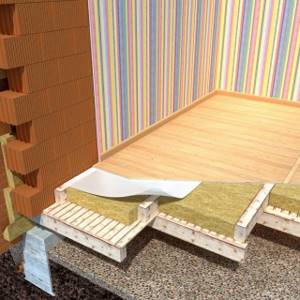
The climatic conditions of a particular area play a big role. But in any case, the main insulation materials are:
| Styrofoam | If the floor is above the ground, then the thickness of the insulation should be 300mm, if there is a wooden floor - 200mm, for interfloor floors 150mm is enough |
| Ecowool | The thickness of the layers is the same as glass wool |
| Glass wool | For the first floor, the insulation layer should not be less than 400mm, if there is a basement, the thickness can be reduced to 300mm, wooden floors - 200mm, floors in an apartment building - 100mm |
| Penoizol | It is identical in thickness to foam plastic for different floors |
| Expanded clay | If the floor borders the ground, then the thickness of the insulation should not be less than 400mm, if there are wooden floors - 300mm, between floors the insulation layer should be 200mm. In apartment buildings, the layer thickness is from 50mm to 80mm. |
| Cork material | The thickness of the insulation in a private house is 100mm, between floors - 50mm, if there are wooden floors, the thickness can be increased by 20mm. Floors in a multi-storey residential building require insulation thickness from 10mm to 30mm. |
| Polystyrene concrete | The floor in individual residential buildings requires a thickness of insulation of 200 mm; between floors, 100 mm is sufficient. In residential high-rise buildings, the layer should be 50mm. |
Thermal conductivity coefficient of materials.
The table below shows the values of the thermal conductivity coefficient for some materials used in construction.
| Material | Coeff. warm W/(m2*K) |
| Alabaster slabs | 0,470 |
| Aluminum | 230,0 |
| Asbestos (slate) | 0,350 |
| Fibrous asbestos | 0,150 |
| Asbestos cement | 1,760 |
| Asbestos cement slabs | 0,350 |
| Asphalt | 0,720 |
| Asphalt in floors | 0,800 |
| Bakelite | 0,230 |
| Concrete on crushed stone | 1,300 |
| Concrete on sand | 0,700 |
| Porous concrete | 1,400 |
| Solid concrete | 1,750 |
| Thermal insulating concrete | 0,180 |
| Bitumen | 0,470 |
| Paper | 0,140 |
| Light mineral wool | 0,045 |
| Heavy mineral wool | 0,055 |
| Cotton wool | 0,055 |
| Vermiculite sheets | 0,100 |
| Woolen felt | 0,045 |
| Construction gypsum | 0,350 |
| Alumina | 2,330 |
| Gravel (filler) | 0,930 |
| Granite, basalt | 3,500 |
| Soil 10% water | 1,750 |
| Soil 20% water | 2,100 |
| Sandy soil | 1,160 |
| The soil is dry | 0,400 |
| Compacted soil | 1,050 |
| Tar | 0,300 |
| Wood - boards | 0,150 |
| Wood - plywood | 0,150 |
| Hardwood | 0,200 |
| Chipboard | 0,200 |
| Duralumin | 160,0 |
| Reinforced concrete | 1,700 |
| Wood ash | 0,150 |
| Limestone | 1,700 |
| Lime-sand mortar | 0,870 |
| Iporka (foamed resin) | 0,038 |
| Stone | 1,400 |
| Multilayer construction cardboard | 0,130 |
| Foamed rubber | 0,030 |
| Natural rubber | 0,042 |
| Fluorinated rubber | 0,055 |
| Expanded clay concrete | 0,200 |
| Silica brick | 0,150 |
| Hollow brick | 0,440 |
| Silicate brick | 0,810 |
| Solid brick | 0,670 |
| Slag brick | 0,580 |
| Siliceous slabs | 0,070 |
| Brass | 110,0 |
| Ice 0°C | 2,210 |
| Ice -20°С | 2,440 |
| Linden, birch, maple, oak (15% humidity) | 0,150 |
| Copper | 380,0 |
| Mipora | 0,085 |
| Sawdust - backfill | 0,095 |
| Dry sawdust | 0,065 |
| PVC | 0,190 |
| Foam concrete | 0,300 |
| Polystyrene foam PS-1 | 0,037 |
| Polyfoam PS-4 | 0,040 |
| Polystyrene foam PVC-1 | 0,050 |
| Foam resopen FRP | 0,045 |
| Expanded polystyrene PS-B | 0,040 |
| Expanded polystyrene PS-BS | 0,040 |
| Polyurethane foam sheets | 0,035 |
| Polyurethane foam panels | 0,025 |
| Lightweight foam glass | 0,060 |
| Heavy foam glass | 0,080 |
| Glassine | 0,170 |
| Perlite | 0,050 |
| Perlite-cement slabs | 0,080 |
| Sand 0% moisture | 0,330 |
| Sand 10% moisture | 0,970 |
| Sand 20% humidity | 1,330 |
| Burnt sandstone | 1,500 |
| Facing tiles | 1,050 |
| Thermal insulation tile PMTB-2 | 0,036 |
| Polystyrene | 0,082 |
| Foam rubber | 0,040 |
| Portland cement mortar | 0,470 |
| Cork board | 0,043 |
| Cork sheets are lightweight | 0,035 |
| Cork sheets are heavy | 0,050 |
| Rubber | 0,150 |
| Ruberoid | 0,170 |
| Slate | 2,100 |
| Snow | 1,500 |
| Scots pine, spruce, fir (450…550 kg/cub.m, 15% humidity) | 0,150 |
| Resinous pine (600…750 kg/cub.m, 15% humidity) | 0,230 |
| Steel | 52,0 |
| Glass | 1,150 |
| Glass wool | 0,050 |
| Fiberglass | 0,036 |
| Fiberglass | 0,300 |
| Wood shavings - stuffing | 0,120 |
| Teflon | 0,250 |
| Paper roofing felt | 0,230 |
| Cement boards | 1,920 |
| Cement-sand mortar | 1,200 |
| Cast iron | 56,0 |
| Granulated slag | 0,150 |
| Boiler slag | 0,290 |
| Cinder concrete | 0,600 |
| Dry plaster | 0,210 |
| Cement plaster | 0,900 |
| Ebonite | 0,160 |
Thermal conductivity indicators for finished buildings. Types of insulation
When creating a project, you need to consider all ways of heat leakage. It can come out through walls and roofs, as well as through floors and doors. If you carry out design calculations incorrectly, you will have to be content only with the thermal energy received from heating devices. Buildings built from standard raw materials: stone, brick or concrete need to be additionally insulated.
Installation of mineral wool
Additional thermal insulation is carried out in frame buildings. At the same time, a wooden frame gives rigidity to the structure, and insulating material is laid in the space between the posts. In buildings made of brick and cinder blocks, insulation is done from the outside of the structure.
When choosing insulation materials, you need to pay attention to factors such as humidity levels, the influence of elevated temperatures and the type of structure. Consider certain parameters of insulating structures:
- the thermal conductivity indicator affects the quality of the heat-insulating process;
- moisture absorption is of great importance when insulating external elements;
- thickness affects the reliability of insulation. Thin insulation helps preserve the usable area of the room;
- Flammability is important. High-quality raw materials have the ability to self-extinguish;
- thermal stability reflects the ability to withstand temperature changes;
- environmental friendliness and safety;
- Sound insulation protects against noise.
Characteristics of different types of insulation
The following types of insulation are used:
mineral wool is fire resistant and environmentally friendly. Important characteristics include low thermal conductivity;
This material is one of the most affordable and simplest options.
- polystyrene foam is a lightweight material with good insulating properties. It is easy to install and is moisture resistant. Recommended for use in non-residential buildings;
- basalt wool, unlike mineral wool, has better resistance to moisture;
- Penoplex is resistant to humidity, elevated temperatures and fire. It has excellent thermal conductivity, is easy to install and durable;
Penoplex is characterized by a porous structure
- polyurethane foam is known for such qualities as non-flammability, good water-repellent properties and high fire resistance;
- Extruded polystyrene foam undergoes additional processing during production. Has a uniform structure;
This option comes in different thicknesses
penofol is a multi-layer insulating layer. The composition contains foamed polyethylene. The surface of the plate is covered with foil to provide reflection.
Bulk types of raw materials can be used for thermal insulation. These are paper granules or perlite. They are resistant to moisture and fire. And among organic varieties, you can consider wood fiber, flax or cork.
When choosing, pay special attention to such indicators as environmental friendliness and fire safety
Manufacturers and types
However, modern materials, thanks to the latest technologies, can have different densities despite the fact that they are made from exactly the same raw materials.
Fiber raw materials
Basalt wool has an average value of 50-200 kg/m3 - the range is wide. The maximum value belongs to options intended for floors and roofs.

Thus, TechnoNikol Galatel basalt slabs have a specific gravity of 195 kg/m3. Dahrok basalt wool from Rockwool, 190 kg/m3, is intended for insulation under roll roofing. Knauf Insulation HTB basalt fiber with a low density of 35 kg/m3 is intended for frame structures and prefabricated buildings. TechnoNikol Rocklight mineral wool in 30-40 kg/m3 is a lightweight insulation option, and the same Knauff company produces Knauff NTV in a density variation of 150 kg/m3.
Foam materials
The density of foam plastic is about 100-150 kg/m3 - the densest slabs are needed for finishing the roof or floors. Manufacturers clearly divide foam boards by area of application, when the specific gravity changes accordingly. Extruded polystyrene foam at 28-35 kg/m3 is one of the lightest materials and the most heat-insulating.
For example, TechnoNikol Carbon Sand with a rating of 28 kg/m3 is used for sandwich panels, and TechnoNikol Carbon Prof with a rating of 30-35 kg/m3 is applicable for insulating walls and load-bearing structures. Plates from the same manufacturer with a density of 50-60 kg/m3 are used for road construction. Penoplex Wall has a differentiated density: 25 kg/m3 - for insulating vertical structures, 47 kg/m3 - for road construction.
Thermal conductivity coefficient of building materials - tables
The thermal insulation properties of materials are perfectly demonstrated by summary tables that present standard indicators.
Table of heat transfer coefficients of materials. Part 1
Heat conductivity of materials. Part 2 Table of thermal conductivity of insulating materials for concrete floors
But these tables of thermal conductivity of materials and insulation materials do not take into account all the values. Let's take a closer look at the heat transfer of basic building materials.
Brick thermal conductivity table
As we have already seen, brick is not the “warmest” wall material. In terms of thermal efficiency, it lags behind wood, foam concrete and expanded clay. But with proper insulation, it makes for cozy and warm homes.
Comparison of thermal conductivity of building materials by thickness (brick and foam concrete)
But not all types of brick have the same thermal conductivity coefficient (λ). For example, for clinker it is the largest - 0.4−0.9 W/(m K). Therefore, it is impractical to build something out of it. Most often it is used for road work and laying floors in technical buildings. The smallest coefficient of this characteristic is for the so-called thermal ceramics - only 0.11 W/(m K). But such a product is also very fragile, which minimizes its scope of application.
A good match between strength and thermal efficiency of sand-lime bricks. But masonry made from them also needs additional insulation, and depending on the region of construction, perhaps also thickening the wall. Below is a comparative table of heat conductivity values for different types of bricks.
Thermal conductivity of different types of bricks
Table of thermal conductivity of metals
The thermal conductivity of metals is no less important in construction, for example, when choosing heating radiators. Also, such values cannot be avoided when welding critical structures, producing semiconductors and various insulators. Below are comparative tables of the thermal conductivity of various metals.
Thermal efficiency of different types of metals. Part 1 Thermal efficiency of different types of metals. Part 2 Thermal efficiency of different types of metals. Part 3
Wood thermal conductivity table
Wood in construction is unofficially classified as an elite material for building houses. And this is not only because of environmental friendliness and high cost. Wood has the lowest thermal conductivity coefficients. Moreover, such values directly depend on the breed. The lowest coefficient among building species is cedar (only 0.095 W/(m∙C)) and cork. Building houses from the latter is very expensive and problematic. But cork for flooring is valued because of its low heat conductivity and good sound insulation qualities. Below are tables of thermal conductivity and strength of various rocks.
Heat conductivity of woodStrength of different types of wood
Table of thermal conductivity of concrete
Concrete in its various variations is the most common building material today, although it is not the “warmest”. In construction, a distinction is made between structural and thermal insulating concrete. The former are used to build foundations and critical components of buildings with subsequent insulation, while the latter are used to build walls. Depending on the region, either additional insulation is applied to them or not.
Comparative table of thermal insulation concrete and thermal conductivity of various wall materials
Aerated concrete is considered the most “warm” and durable. Although this is not entirely true. If you compare the structure of foam blocks and aerated concrete, you can see significant differences. In the first, the pores are closed, while in gas silicates, most of them are open, as if “torn.” This is why in windy weather an uninsulated house made of aerated blocks is very cold. The same reason makes such lightweight concrete more susceptible to moisture.
What is the thermal conductivity coefficient of the air gap?
In construction, windproof air layers are often used, which only increase the heat conductivity of the entire building. Also, such vents are necessary to remove moisture outside.
Particular attention is paid to the design of such layers in foam concrete buildings for various purposes. Such layers also have their own thermal conductivity coefficient depending on their thickness
Table of heat conductivity of air layers
Table of thermal conductivity coefficients of different materials
Based on the table with the thermal conductivity coefficients of building materials and popular insulation materials, a comparative analysis can be made. It will ensure the selection of the optimal thermal insulation option for the building.
| Material | Thermal conductivity, W/m*K | Thickness, mm | Density, kg/m³ | Laying temperature, °C | Vapor permeability, mg/m²*h*Pa |
| Polyurethane foam | 0,025 | 30 | 40-60 | -100 to +150 | 0,04-0,05 |
| Extruded polystyrene foam | 0,03 | 36 | 40-50 | -50 to +75 | 0,015 |
| Styrofoam | 0,05 | 60 | 40-125 | -50 to +75 | 0,23 |
| Mineral wool (slabs) | 0,047 | 56 | 35-150 | -60 to +180 | 0,53 |
| Fiberglass (slabs) | 0,056 | 67 | 15-100 | From +60 to +480 | 0,053 |
| Basalt wool (slabs) | 0,037 | 80 | 30-190 | -190 to +700 | 0,3 |
| Reinforced concrete | 2,04 | 2500 | 0,03 | ||
| Hollow brick | 0,058 | 50 | 1400 | 0,16 | |
| Wooden beams with cross section | 0,18 | 15 | 40-50 | 0,06 |
For thickness parameters, an average value was used.
Thermal conductivity
Any material can conduct heat. This process is carried out due to the movement of particles, which transmit temperature changes. The closer they are to each other, the faster the heat exchange process occurs. Thus, denser materials and substances cool or heat up much faster. The intensity of heat transfer primarily depends on density. It is expressed numerically through the thermal conductivity coefficient. It is designated by the symbol λ and measured in W/(m*°C). The higher this coefficient, the higher the thermal conductivity of the material. The reciprocal of thermal conductivity is thermal resistance. It is measured in (m2*°C)/W and is designated by the letter R.
What is thermal conductivity?
Thermal conduction can be described as the process of transferring thermal energy until thermal equilibrium occurs.
The temperature, one way or another, will be equalized, the only question is the speed of this process. If we apply this concept to a house, it is clear that the longer the temperature inside the building equalizes with the outside, the better. Simply put, how quickly a house cools down is a matter of what the thermal conductivity of its walls is. In numerical form, this indicator is characterized by thermal conductivity coefficient . It shows how much heat passes through a unit of surface per unit time. The higher this coefficient is for a material, the faster it conducts heat.
The thermal conductivity of insulation is the most informative indicator, and the lower it is, the more effectively the material retains heat (or coolness on hot days). But there are other indicators that influence the choice of insulation.
Table of thermal conductivity of insulation
The table shows data on the most widely used insulation materials used in private construction: mineral wool, expanded polystyrene, polyurethane foam and polystyrene foam. Comparative data for other types is also provided.
Table of thermal conductivity of insulation
| Thermal conductivity, W/(m*S) | Density, kg/m3 | Vapor permeability, mg/ (m*h*Pa) | «+» | «-» | Flammable |
| Polyurethane foam | 0,023 | 32 | 0,0-0,05 | 2.Seamless foam installation; 3.Long term; 4.Better heat and waterproofing | 1. not cheap 2. Not resistant to UV radiation | Self-extinguishing |
| 0,029 | 40 | |||||
| 0,035 | 60 | |||||
| 0,041 | 80 | |||||
| Expanded polystyrene (foam) | 0,038 | 40 | 0,013-0,05 | 1. Excellent insulation; 2. Cheap; 3. Waterproof | 1. Fragile; 2. Does not “breathe” and forms condensation | G3 and G4. Fire resistance and self-extinguishing |
| 0,041 | 100 | |||||
| 0,05 | 150 | |||||
| Extruded polystyrene foam | 0,031 | 33 | 0,013 | 1.Very low thermal conductivity; 3.Moisture-proof; 4. Compressive strength; 5. Does not rot or mold; 6. Operation from -50°C to +75°C; 7.Easy to install. | 1. Much more expensive than polystyrene foam; 2. Susceptible to organic solvents; 3. Vapor permeability is low, condensation forms. | G1 for brands with anti-foam additives, others G3 and G4. Fire resistance and self-extinguishing |
| Mineral (basalt) wool | 0,048 | 50 | 0,49-0,6 | 1.Good vapor permeability – “breathes”; 2.Resists fungi; 3.Sound insulation; 4.High thermal insulation; 5.Mechanical strength; 6.Does not crumble | 1.Not cheap | Refractory |
| 0,056 | 100 | |||||
| 0,07 | 200 | |||||
| Fiberglass (glass wool) | 0,041-0,044 | 155-200 | 0,5 | 1.Low thermal conductivity; 2.Does not emit toxic substances during fires | 1.Over time, thermal insulation decreases; 2. Mold may appear; 3.Problematic installation: fibers fall off and harm the skin and eyes; 4. Vapor permeability is low, condensation forms. | Does not burn |
| PVC foam | 0,052 | 125 | 0,023 | 1.Rigid and easy to install | 1. Short-lived; 2. Poor vapor permeability and condensation formation | G3 and G4. Fire resistance and self-extinguishing |
| Wood sawdust | 0,07-0,18 | 230 | — | 1.Cheap; 2.Environmentally friendly | 1.Deteriorates and rots; 2.Thermal insulation properties decrease at high humidity | Fire hazardous |
Comparing “+” and “-” will help determine which insulation to choose for specific purposes.
Useful indicators of insulation
What are the main indicators you need to pay attention to when choosing insulation:
- Thermal conductivity is the main indicator when choosing a material insulation. The lower it is, the better the thermal insulation of this material;
- Density directly affects the mass of the material; it determines what additional load will be placed on the walls or floors of the house. This is very easy to calculate, knowing the volume of insulation and its density. Typically, thermal insulation properties decrease with increasing material density. The lighter the insulation, the easier it is to work with, and the load on the floors will be minimal;
- Vapor permeability shows how a material allows water vapor to pass through. A high coefficient indicates that the material can be moistened. On the contrary, a low coefficient indicates that the material does not allow steam to pass through and forms condensation. Materials can be divided into 2 types: a) cotton wool - materials consisting of fibers. They are vapor permeable; b) foam is a hardened foam mass of a special substance. Do not allow steam to pass through;
- Water absorption is the ability of a substance to absorb water. The higher it is, the less suitable the material is for insulation, especially for external thermal insulation work, bathrooms, kitchens and other places with high humidity;
- Flammability is a fairly understandable indicator; it is obvious that the best materials for insulation are those that do not burn. Self-extinguishing options are also suitable;
- Compressive strength is the ability of a material to retain its shape and thickness under mechanical stress. Many materials are good as insulation, but can shrink, thereby reducing their thermal insulation qualities;
- Fragility is undesirable for insulation, although it is not a fundamental quality when choosing;
- Durability determines the service life of a material;
- The thickness of the material determines how much space the insulation will occupy. This is important for interior work, because the thinner the layer of material, the less useful space it will “eat”;
- The environmental friendliness of the material is especially important when performing internal insulation. It is necessary to pay attention to whether the insulation does not decompose into dangerous components, and whether it does not release toxic substances during a fire.
Importance in everyday life and production
Application of thermal conductivity in construction
Each material has its own thermal conductivity index. The lower its value, the correspondingly lower the level of heat exchange between the external and internal environment. This means that a building constructed from a material with low thermal conductivity will be warm in winter and cool in summer.
Heat losses at the seams of a panel house
When constructing various buildings, including residential buildings, it is impossible to do without knowledge about the thermal conductivity of building materials. When designing building structures, it is necessary to take into account data on the properties of materials such as concrete, glass, mineral wool and many others. Among them, the maximum thermal conductivity belongs to concrete, while for wood it is 6 times less.
Heating systems
The key task of any heating system is the transfer of thermal energy from the coolant to the premises. For such heating, batteries or radiators are used. They are necessary to transfer thermal energy into rooms.
- A heating radiator is a structure inside that moves coolant. The main characteristics of this product include: the material from which it is made;
- type of construction;
- dimensions, including the number of sections;
- heat transfer indicators.
It is heat transfer that is the key parameter. The whole point is that it determines the amount of energy that is transferred from the radiator to the room. The higher this indicator, the lower the heat loss will be. There are reference tables that determine the materials that are optimal for use in heating systems. From the data they contain, it becomes clear that copper is considered the most effective material. But, due to its high price and certain technological difficulties associated with copper processing, their applicability is not so high.
Bimetallic radiator
That is why models made of steel or aluminum alloys are increasingly being used. A combination of different materials, for example, steel and aluminum, is often used. Each radiator manufacturer, when labeling finished products, must indicate such a characteristic as the thermal output power. On the heating systems market, you can purchase radiators made of cast iron, steel, aluminum and bimetal.
Which insulation is better for the ceiling
There are several ways of ceiling insulation: from above (from the attic) or from below (from the room). There are five main types of insulation for such work:
| Mineral wool | It has a thickness of 20mm to 200mm, is sold in bales or rolls, and may have one foil side to improve thermal insulation properties. |
| Foiled polyethylene foam | Thickness from 1mm to 20mm, rolls 1m wide. Effective, can be used as a second layer to mineral wool to increase the power of the thermal barrier. |
| Styrofoam | Sold in squares with sides of 1m and thickness from 20mm to 100mm. Density ranges from 15kg/sq.m. up to 25kg/sq.m. They are used as intermediate insulation before installing suspended and suspended frames or as a rough base before filling the ceiling. |
| Polyplex | Presented in the form of sheets 120cm x 60cm, thickness from 10mm to 200mm, in a variety of colors and with special bevels for installation. Products with a density of 35 kg/m2 are in great demand. or 45kg/sq.m. Used as a rough coat before puttying. |
| Expanded clay | It has a porous structure, light weight, and oval shape. The attic floor is covered with it to create a thermal cushion under the screed. |
Ceiling insulation from above
Any insulation is suitable for the attic, especially since there is no need to attach them. They are laid tightly on the surface so that there are no gaps or cracks through which heat will escape. Products that are not too expensive are suitable for these purposes, as long as the thermal insulation properties are at their best. The main insulation materials are mineral wool and expanded clay.

Insulation of the ceiling from below
You definitely need to take care of the hanging frame or special fastenings, since fastening work is carried out on weight. The easiest way is to fill the voids between the base and the suspended ceiling with thermal insulation material. You can also use U-shaped hangers. In this case, the insulation is threaded inside the devices, and then profiles made of wood or metal are installed. But this method is only suitable if the height of the ceiling allows them to be reduced by lowering the frame.


